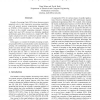Free Online Productivity Tools
i2Speak
i2Symbol
i2OCR
iTex2Img
iWeb2Print
iWeb2Shot
i2Type
iPdf2Split
iPdf2Merge
i2Bopomofo
i2Arabic
i2Style
i2Image
i2PDF
iLatex2Rtf
Sci2ools
108
click to vote
IPPS
2009
IEEE
2009
IEEE
Exploring the multiple-GPU design space
Graphics Processing Units (GPUs) have been growing in popularity due to their impressive processing capabilities, and with general purpose programming languages such as NVIDIA’s CUDA interface, are becoming the platform of choice in the scientific computing community. Previous studies that used GPUs focused on obtaining significant performance gains from execution on a single GPU. These studies employed low-level, architecture-specific tuning in order to achieve sizeable benefits over multicore CPU execution. In this paper, we consider the benefits of running on multiple (parallel) GPUs to provide further orders of performance speedup. Our methodology allows developers to accurately predict execution time for GPU applications while varying the number and configuration of the GPUs, and the size of the input data set. This is a natural next step in GPU computing because it allows researchers to determine the most appropriate GPU configuration for an application without having t...
Related Content
| Added | 24 May 2010 |
| Updated | 24 May 2010 |
| Type | Conference |
| Year | 2009 |
| Where | IPPS |
| Authors | Dana Schaa, David R. Kaeli |
Comments (0)

